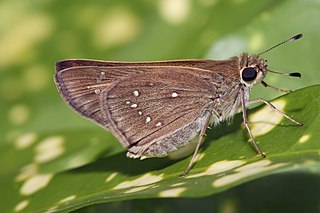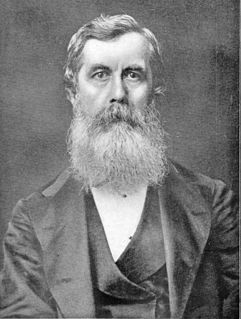
Skippers are a family, Hesperiidae, of the Lepidoptera. Being diurnal, they are generally called butterflies. They were previously placed in a separate superfamily, Hesperioidea; however, the most recent taxonomy places the family in the superfamily Papilionoidea. They are named for their quick, darting flight habits. Most have the antenna tip modified into a narrow hook-like projection. More than 3500 species of skippers are recognized, and they occur worldwide, but with the greatest diversity in the Neotropical regions of Central and South America.

Henry Doubleday was an English entomologist and ornithologist.

Francis Walker was an English entomologist. He was one of the most prolific authors in entomology, and stirred controversy during his later life as his publications resulted in a huge number of junior synonyms.
Sir George Francis Hampson, 10th Baronet was a British entomologist.

Arthur Gardiner Butler was an English entomologist, arachnologist and ornithologist. He worked at the British Museum working on the taxonomy of birds, insects, and spiders.

Nepticulidae is a family of very small moths with a worldwide distribution. They are characterised by eyecaps over the eyes. These pigmy moths or midget moths, as they are commonly known, include the smallest of all living moths, with a wingspan that can be as little as 3 mm in the case of the European pigmy sorrel moth, but more usually 3.5–10 mm. The wings of adult moths are narrow and lanceolate, sometimes with metallic markings, and with the venation very simplified compared to most other moths.

John Henry Leech was an English entomologist who specialised in Lepidoptera and Coleoptera.
Pseudosphenoptera is a genus of moths in the subfamily Arctiinae.

Frederic Moore FZS was a British entomologist. He was also an illustrator and produced six volumes of Lepidoptera Indica and a catalogue of the birds in the collection of the East India Company.
The Global Lepidoptera Names Index (LepIndex) is a searchable database maintained by the Department of Entomology at the Natural History Museum, London.
Amerila luteibarba is a moth of the subfamily Arctiinae. It was described by George Hampson in 1901. It is found in Angola, Benin, Cameroon, the Democratic Republic of the Congo, Gabon, Ghana, Ivory Coast, Kenya, Liberia, Nigeria, Rwanda, Sierra Leone, Tanzania, Togo and Uganda.
Argyroeides nephelophora is a moth of the subfamily Arctiinae. It was described by George Hampson in 1914. It is found in Paraguay.
Epidesma similis is a moth of the subfamily Arctiinae. It was described by Rothschild in 1912. It is found in Brazil.

Neasura hypophaeola is a moth of the subfamily Arctiinae. It was described by George Hampson in 1900. It is found on the Sangihe Islands.

Pheia discophora is a moth in the subfamily Arctiinae. It was described by Paul Dognin in 1909. It is found in Colombia.
Pseudosphenoptera almonia is a moth in the subfamily Arctiinae. It is found in Peru.
Pseudosphenoptera boyi is a moth in the subfamily Arctiinae. It is found in Brazil.
Pseudosphenoptera chimaera is a moth in the subfamily Arctiinae. It is found in Peru.
Pseudosphenoptera cocho is a moth in the subfamily Arctiinae. It was described by Schaus in 1896. It is found in Brazil, the Upper Amazons and Peru.
Meridarchis eremitis is a moth in the Carposinidae family. It was described by Meyrick in 1905. It is found in Sri Lanka.











